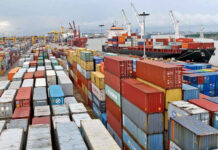In the last fiscal year amid the COVID-19 crisis, Chattogram port has achieved growth in all the indicators of performance index. Compared to the last fiscal year, the port has handled 11.98% more cargo and 3.1% more containers. Besides, about 7.92% more ships have been handled.
In the fiscal year 2020-21, 11 crore 37 lac 29 thousand and 373 metric tons of cargo has been handled in Chattogram port by combining import and export. In the previous fiscal year, it was 10 crore 15 lac 65 thousand and 272 metric tons. As a result, the growth in cargo handling at the port has been 11.98%.
In the fiscal year 2020-21, the container handling at Chattogram port has been 30 lac 97 thousand and 236 TEUs (each 20 feet in length). In the previous fiscal year, the container handling was 30 lac 4 thousand and 142 TEUs. As a result, the growth of container handling at the port has been 3.1%.
In the same fiscal year, 4,062 ships were handled at the port’s jetty and outer anchorage. In the previous fiscal year, it was 3,764. As a result, ship handling has grown by 9.72%.
The monthly review of the fiscal year 2020-21 shows that the highest import-export combined cargo handling was done in April of this year. During the month, the imported cargo handling was 1 crore 10 lac 52 thousand and 763 metric tons and the exported cargo handling was 6 lac 1 thousand and 315 metric tons. In total, 1 crore 16 lac 54 thousand and 68 metric tons of cargo was handled during that month.
Chattogram port handles more than 92% of Bangladesh’s imports and exports and 98% of container goods. The port handles an average of about 7,000 containers per day. And the revenue collection is thousands of crores of taka daily.
However, despite the strict restrictions of the second phase of the COVID-19 outbreak, preparations have been made in advance to keep this port running, which contributes to the country’s economy. The activities of the port have been kept running in a planned manner by utilising the experience of the first phase. Although the presence of officers and employees in the office has been controlled to some extent, the attendance of all was ensured in accordance with the hygiene guidelines during the operational work.




